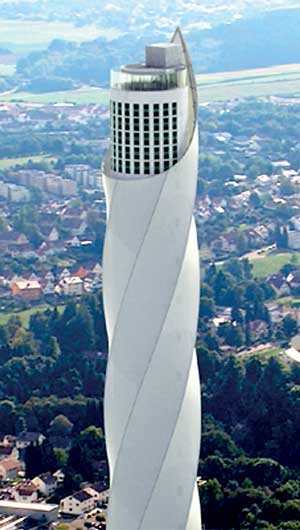Sunday Feb 09, 2025
Sunday Feb 09, 2025
Tuesday, 18 July 2017 00:00 - - {{hitsCtrl.values.hits}}
Thyssenkrupp, one of the world’s leading elevator companies, has unveiled its revolutionary rope-less and sideways-moving elevator system, Multi, a first-of-its-kind in the world.
One of the industry’s most forward-thinking innovations created since the  19th century: the world’s first rope-less and sideways-moving elevator system, Multi, was unveiled at the 246-m tall test tower in Rottweil, Germany.
19th century: the world’s first rope-less and sideways-moving elevator system, Multi, was unveiled at the 246-m tall test tower in Rottweil, Germany.
Instead of one cabin per shaft moving up and down, the Multi offers multiple cabins operating in loop, like a metro system inside a building. Without the use of cables, the system runs on a safe multi-level brake system and redundant wireless data and energy management on the cars, said the German industrial giant.
The much anticipated concept today becomes a reality, as thyssenkrupp launches the first fully functional unit at its purpose-built innovation test tower in Rottweil, Germany, it added.
More than 160 years after the invention of the conventional elevator, the top German multinational conglomerate disrupts the industry by unveiling the first functional horizontal-vertical elevator system Multi at the 246-m tall tower, said a top official.
Commenting on the launch, Andreas Schierenbeck, the Chief Executive of thyssenkrupp Elevator, said: “We believe Multi is a genuine gamechanger that will truly transform the way people move, work and live in our built environment. It will reduce waiting times for passengers and take up significantly less space within the building.”
“Multi is a key offering that truly represents a landmark revolution in the elevator industry,” he noted.
Multi requires fewer and smaller shafts than conventional elevators and can increase the building’s usable area by up to 25%, representing extra revenues from the additional rentable/leasable space, explained Schierenbeck.
This is particularly important considering current elevator-escalator footprints can occupy up to 40% of a high-rise building’s floor space, depending on the building height, he noted.
Multi can achieve up to 50% higher transport capacity and reduce peak power demand by as much as 60% when compared to conventional elevator systems, these two factors mean a dramatic improvement for high-rise buildings, they stated.
Additionally, since Multi can move sideways as well as vertically, and without any height limitations, it enables unprecedented possibilities in the architecture and design of buildings, they added.
According to experts, the Multi requires dramatically lower peak power permitting a better management of the building’s energy needs, consequently reducing the investment costs in the power supply infrastructure.
Discover Kapruka, the leading online shopping platform in Sri Lanka, where you can conveniently send Gifts and Flowers to your loved ones for any event including Valentine ’s Day. Explore a wide range of popular Shopping Categories on Kapruka, including Toys, Groceries, Electronics, Birthday Cakes, Fruits, Chocolates, Flower Bouquets, Clothing, Watches, Lingerie, Gift Sets and Jewellery. Also if you’re interested in selling with Kapruka, Partner Central by Kapruka is the best solution to start with. Moreover, through Kapruka Global Shop, you can also enjoy the convenience of purchasing products from renowned platforms like Amazon and eBay and have them delivered to Sri Lanka.
Discover Kapruka, the leading online shopping platform in Sri Lanka, where you can conveniently send Gifts and Flowers to your loved ones for any event including Valentine ’s Day. Explore a wide range of popular Shopping Categories on Kapruka, including Toys, Groceries, Electronics, Birthday Cakes, Fruits, Chocolates, Flower Bouquets, Clothing, Watches, Lingerie, Gift Sets and Jewellery. Also if you’re interested in selling with Kapruka, Partner Central by Kapruka is the best solution to start with. Moreover, through Kapruka Global Shop, you can also enjoy the convenience of purchasing products from renowned platforms like Amazon and eBay and have them delivered to Sri Lanka.